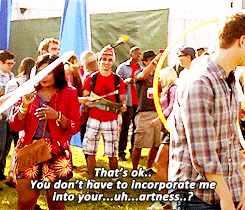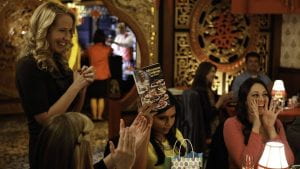Boboltz, Sara. “TV Still Perpetuates A Whole Mess of Gender Stereotypes.” The Huffington Post, TheHuffingtonPost.com, 12 September 2017, www.huffingtonpost.com/entry/tvgender stereotypes-boxed-in-report-2017_us_59b814cce4b02da0e13cac47.
This source offers basic insight on the ways in which women’s activities are portrayed on television. By analyzing over 4000 characters across a wide, diverse range of television shows, the author discovered that women are still disproportionately overrepresented in personal roles, such as being wives or mothers. Thus, male characters are left to fill the work-oriented roles. One counterpoint the author addressed is within “The Handmaid’s Tale”, where women’s lack of workplace jobs is hyperbolically used to emphasize the lack of women’s rights. However, she argued that this representation, even when the aim is to ridicule the current treatment of women, is still perpetuating and reinforcing gender roles. Furthermore, the author attributed the high frequency of stereotypically gendered jobs on television to the lack of women working on these shows behind the scenes. When women are employed in the creative teams behind the shows, the representation of women increases to equal the actual proportion of women in the US. This source offers insightful, albeit superficial, analysis on women’s jobs on television shows. The source only focuses on television as a whole, and thus misses the potential discrepancies across networks or genres. This source is beneficial for its confirmation of the suspicion that television shows generally rely on harmful gender stereotypes when creating characters.
Durkin, Kevin, and Bradley Nugent. “Kindergarten Children’s Gender-Role Expectations for Television Actors.” Sex Roles, vol. 38, no. 5, 1998, pp. 387-402. ProQuest http://prx.library.gatech.edu/login?url=https://search.proquest.com/docview/225373743?accountid=11107.
This research confirms that kindergarten aged children are already aware of gender stereotyping and can guess the gender of a television character based on the type of activity being performed. The children answered with strong correlations to traditional stereotypes for both male and female activities and as they age, their responses align more strongly towards stereotypical gender roles. This study found that both young boys and girls found their gender roles to be rigid. This demonstrates that from an early age, children are aware of social expectations and internalize them, which then affects how they view their own competence within the world. As for where these expectations stem from, the authors argue that television is a strong contributor as children watch such a high amount of television that it forms a portion of their own reality. However, there are weakness associated with this data: this only covered a special case for the children and may not be reflective of their general viewing attitudes. Given the source’s focus on how children’s gender expectations affect their television viewing and the high-quality composition of the source, it offers helpful insight on how children can be socially conditioned by television.
Faniyi, Oluwakemi. “Gender Roles in Children’s Television.” The Odyssey Online, 28 August 2017,www.theodysseyonline.com/gender-roles-in-childrens-television.
This source argues that due to the high amount of time children spending watching television, especially during their formative brain development years, television grooms children to align themselves with specific gender roles. Through constant reinforcement, children learn to accept gender stereotypes are they are portrayed in the media, specifically television. This creates many adverse effects for children; lack of gender representation may give children the idea that female stories are not important, furthermore, stereotypical gender representation can affect opinions about occupations or interpersonal relationships. Although this source specifically focuses on the skewed representation of gender in the media and the adverse effects on children, the analysis in terms of the effect on children is weak. It contends that children are negatively affected by these gender roles on television, but it never explicitly clarifies what these expectations are. However, it offers apt analysis that explains how children are affected by gender stereotypes in the world around them, including television.
Jennifer, Aubrey, and Kristen Harrison. (2004). “The Gender-Role Content of Children’s Favorite Television Programs and its Links to their Gender-Related Perceptions.” Media Psychology, 6(2), 111-146. http://prx.library.gatech.edu/login?url=https://search.proquest.com/docview/230043335?accountid=11107.
This study discovered that in 1st and 2nd grader’s favorite television shows, male lead characters far outnumber female leads and female characters were far more likely to exhibit stereotypical characteristics (defined here as “attractive” and “frail”). This creates a circular problem with representation, as girls see more male characters, so they choose male characters as role models, but boys do not see female characters, thus they are unable to pick female role models. This encourages network executives to continue making shows with primarily male leads as they are more popular. From the analysis based on cartoons, it was most common for programs to create gender-neutral or gender counter-stereotypical programing, this includes having male characters more likely to cry or follow orders. Although female characters conformed to gender stereotypes based on appearance, their general actions and plot importance was about equivalent to the male characters. This source offers insightful analysis that specifically focuses on gender stereotyping in children’s television through multiple approaches. However, there are still limitations with the data itself, as it only analyzed six television shows, from two networks, so the sample was not representative of all television watched by children. The analysis is invaluable because of its multiple approaches to the problem of gender representation – emotional attitudes, numerical representation and appearance, which will be useful lenses for future analysis.
Johnson, Fern, and Karren Young. (2002). “Gendered Voices in Children’s Television Advertising.” Critical Studies in Media Communication, 19(4), 461-480. http://prx.library.gatech.edu/login?url=https://search.proquest.com/docview/220423928?accountid=11107.
This source argues that children’s advertisements are geared to the gender stereotype that they envelop – “boy” toys are accompanied with an aggressive male voice, and the voiceover for “girl” toys is a sing-song female voice. These voices are clearly caricatures to adults, but to children they can be directly interpreted, leading to a rigid understanding of gender roles. Furthermore, when the language used in these ads is analyzed, the verbs utilized with young girl audiences are associated with emotions, and the verbs for boys are linked to destruction and action. In particular, the portrayal of the genders is different within the television ads – girls are seen in bright colors and in groups, engaging in trivial activities like gossip; the boys are in black and white, and are generally doing something active. These television commercials continue to rely on polarizing gender stereotypes because they have been effective in selling products and allow an acclimation to the gendered world of adult products. This research gives strong evidence for the total immersion of children into gender roles, as commercials, generally thought of as background entertainment, are enlisting the same stereotypes present within regular programming. This source offers apt analysis about how language, images, and voices are used to promote gender stereotypes. Even though commercials is not a primary focus for this research, it still offers high quality, well-thought out criteria and analysis for where gender stereotypes can be identified in the media.
Witt, Susan. (2000). “The Influence of Television on Children’s Gender Role Socialization.” Childhood Education, 76(5), 322-324. http://prx.library.gatech.edu/login?url=https://search.proquest.com/docview/210380519?accountid=11107.
Television is one of the strongest social influences that children experience, and they mirror the behavior and expectations that are portrayed on television. Perceptions and biases are established over time through constant reinforcement, so if children only see women nurses on television, this can become a steadfast, stereotypical belief in the minds of children. When children see males portrayed as decisive and assertive, and females portrayed as passive or subordinate, children begin to believe these are appropriate behaviors for the genders. This is especially problematic when television does not mirror the real world; an unequal workforce, an intense emphasis on relationships for women, and a majority of young, attractive women, establishes expectations that are not reflective of real life. This article is a great example of the power of television in regard to children’s socialization and alignment with gender stereotypes. It is important to understand the implications of what children watch and how that creates a worldview which will eventually lead to biases and prejudices.






